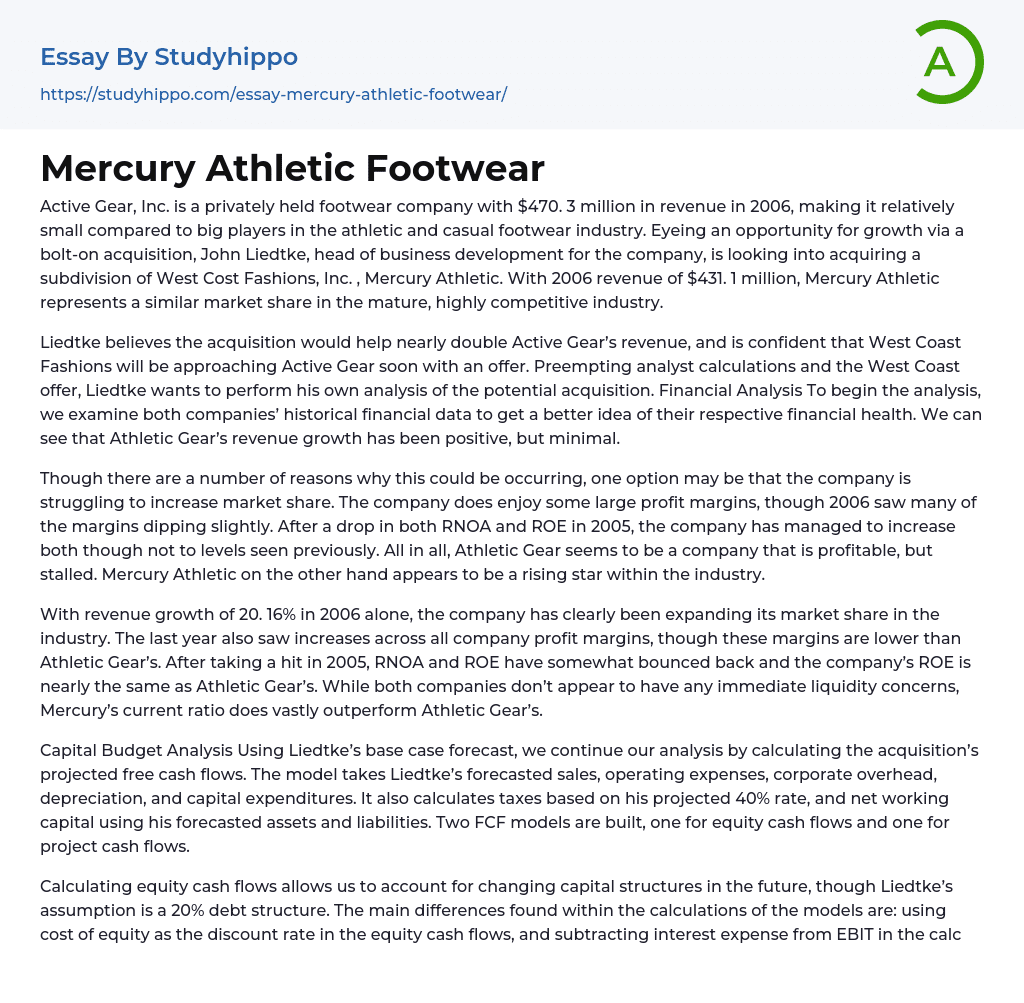Active Gear, Inc. is a privately held footwear company with $470. 3 million in revenue in 2006, making it relatively small compared to big players in the athletic and casual footwear industry. Eyeing an opportunity for growth via a bolt-on acquisition, John Liedtke, head of business development for the company, is looking into acquiring a subdivision of West Cost Fashions, Inc. , Mercury Athletic. With 2006 revenue of $431. 1 million, Mercury Athletic represents a similar market share in the mature, highly competitive industry.
Liedtke believes the acquisition would help nearly double Active Gear’s revenue, and is confident that West Coast Fashions will be approaching Active Gear soon with an offer. Preempting analyst calculations and the West Coast offer, Liedtke wants to perform his own analysis of the potential ac
...quisition. Financial Analysis To begin the analysis, we examine both companies’ historical financial data to get a better idea of their respective financial health. We can see that Athletic Gear’s revenue growth has been positive, but minimal.
Though there are a number of reasons why this could be occurring, one option may be that the company is struggling to increase market share. The company does enjoy some large profit margins, though 2006 saw many of the margins dipping slightly. After a drop in both RNOA and ROE in 2005, the company has managed to increase both though not to levels seen previously. All in all, Athletic Gear seems to be a company that is profitable, but stalled. Mercury Athletic on the other hand appears to be a rising star within the industry.
With revenue growth of 20. 16% in 2006 alone,
the company has clearly been expanding its market share in the industry. The last year also saw increases across all company profit margins, though these margins are lower than Athletic Gear’s. After taking a hit in 2005, RNOA and ROE have somewhat bounced back and the company’s ROE is nearly the same as Athletic Gear’s. While both companies don’t appear to have any immediate liquidity concerns, Mercury’s current ratio does vastly outperform Athletic Gear’s.
Capital Budget Analysis Using Liedtke’s base case forecast, we continue our analysis by calculating the acquisition’s projected free cash flows. The model takes Liedtke’s forecasted sales, operating expenses, corporate overhead, depreciation, and capital expenditures. It also calculates taxes based on his projected 40% rate, and net working capital using his forecasted assets and liabilities. Two FCF models are built, one for equity cash flows and one for project cash flows.
Calculating equity cash flows allows us to account for changing capital structures in the future, though Liedtke’s assumption is a 20% debt structure. The main differences found within the calculations of the models are: using cost of equity as the discount rate in the equity cash flows, and subtracting interest expense from EBIT in the calculation of equity cash flows. Using the case’s 6% cost of debt and an average of the betas provided, we calculate a WACC of 12. 95% for the project. Liedkte assumes a 3% growth rate, which is used in conjunction with WACC to calculate a terminal value in 2011.
After discounting all cash flows, we arrive at NPV’s of $141,553 million and $181,634 million for the equity and project cash flows respectively. Recommendation
Liedtke’s initial interest in the Mercury acquisition was a broad generalized outlook, fueled by the possibility of strategic growth in market share. With Athletic Gear’s organic growth apparently to run stagnant in a mature industry, a bolt-on acquisition such as this could boost sales while taking advantage of economies of scale.
Mercury’s financials point to a company that is healthy and performing well, which lends further credibility to the notion that West Coast Fashions is selling the brand only because of a strategic restructuring, not because it is faltering. The project has a positive NPV, even with a relatively high discount factor. Further analysis should be completed to calculate the project’s sensitivity to a changing discount factor. As one of Liedtke’s top concerns is the possible mark up of the acquisition, he can use the calculated NPVs as a point of reference for the prices Athletic Gear should entertain.
- Investing essays
- Asset essays
- Depreciation essays
- Discounted Cash Flow essays
- Foreign Direct Investment essays
- Funds essays
- Internal Rate Of Return essays
- Revenue essays
- Day Trading essays
- Futures Trading essays
- Capital market essays
- Million essays
- Payment essays
- Rate Of Return essays
- Funding essays
- Hedge Fund essays
- American Football essays
- Athletes essays
- Athletic Shoe essays
- badminton essays
- Baseball essays
- Basketball essays
- Benefits of Exercise essays
- Bodybuilding essays
- Boxing essays
- cricket essays
- Fight club essays
- Football essays
- go kart essays
- Golf essays
- Gym essays
- hockey essays
- Martial Arts essays
- Motorcycle essays
- Olympic Games essays
- Running essays
- scuba diving essays
- Ski essays
- snowboarding essays
- Soccer essays
- Sportsmanship essays
- Super Bowl essays
- Surfing essays
- Swimming essays
- Table tennis essays
- Taekwondo essays
- Tennis essays
- Training essays
- Volleyball essays
- wrestling essays




